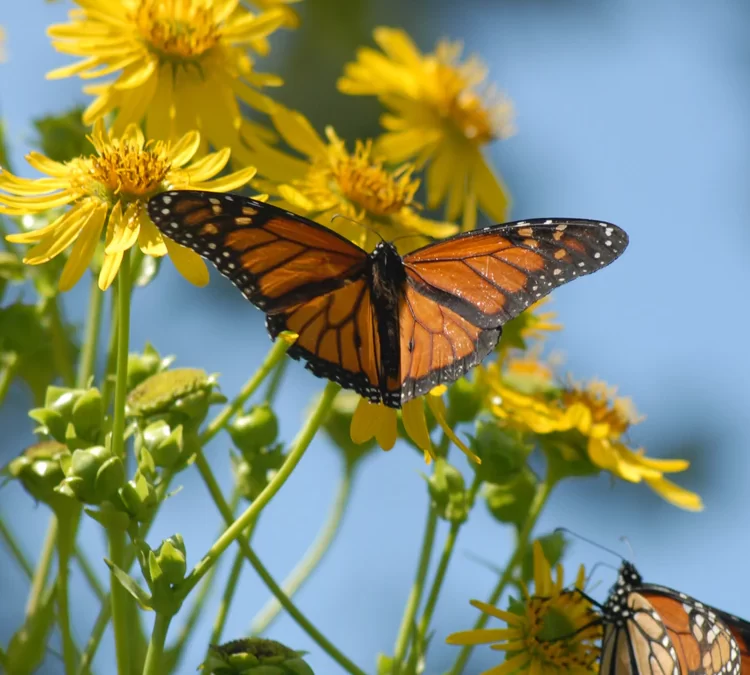By introducing more pollinators to your garden, you can expect higher yields, bigger blooms and more plants! These busy-bee workers aren’t just bees. Pollinators come in a wide variety of insects and mammals. Some fantastic pollinators you can find in Canada are bats, birds, moths, butterflies, flies, wasps, beetles and more. To get you started on attracting more pollinators to your home garden, we’ve created a list of tips to help make these critters feel right at home at your home!
1.) Just Add Water

Like us, our pollinator friends need water to survive! To help keep their wings clean and their thirst quenched, maintain a constant supply of fresh water out for them to rely on. A safe way to do so is by keeping a shallow water dish out with sticks and rocks for perching.
Pro-tip: Try using a refillable dog bowl for a constant fresh water supply.
2.) Less Chemicals, More Nature

While it may seem like an excellent way to get rid of pesky insects, chemical-based products aren’t pollinator friendly. Don’t worry! Chemicals aren’t necessary to get rid of garden pests. In fact, many pollinators like birds, praying mantis, wasps and bats prey on these insects! Making your garden more protein rich for them.
Pro-tip: When in doubt, look for certified organic products!
3.) Single or Double?

The bigger the bloom, the better? Not when it comes to helping our pollinator friends out. With bigger flowers comes more petals to navigate through to get to what really matters -the pollen! To make your garden more appealing for pollinators, introduce single petal blooms for quick and easy pollen access!
4.) Favourite Colours

When we humans look at a garden, we see every colour of the rainbow! Interestingly enough, our bee friends don’t. They see the world through ultraviolet rays, making them unable to see reds! Plant yellows, blues, and purples for high visibility to attract more bees.
Pro-tip: To attract butterflies, plant whites, pinks, purples, reds, yellows and oranges. For hummingbirds, plant plenty of reds!
5.) Group setting

Don’t be shy! Plant more of them when you’ve decided on your favourite pollinator-friendly plants. Planting groups of the same plants together will lure in pollinators like an all-you-can-eat buffet!
Pro-tip: Try naturalizing with plants like Crocus and Snowdrops for mass landscaping.
6.) Hang-out Spots

Like your favourite lazy boy recliner, each pollinator has a favourite hang-out spot. Hummingbirds prefer to hide from the sunshine in shady areas under trees and near bushes. While butterflies and bees prefer energizing in the sunshine. To keep your pollinator guests happy, try placings rocks in the sun for bees and butterflies to catch some rays. While keeping some hummingbird favourites out of the sun so that they can keep their cool.
Pro-tip: For night protection, use a butterfly habit box for butterflies and a mason bee home for mason bees to keep protected from harsh weather.
7.) Bloom time!

The best way to attract pollinators and keep them coming back for more is to have more! Once your blooms are gone, your pollinators will be too. To ensure they stick around, be sure to offer continuous blooms by planning your blooms times. Here is a cheat sheet to keep on hand when you’re planning!
| Early Spring Blooms | Allium, Chionodoxa, Galanthus, Crocus, Hyacinth, Muscari, Narcissus |
| Sprint to Early Summer Blooms | Geranium, Iris, Peony, Foxglove, Columbine, Poppy, Bleeding Heart |
| Early to Mid-Summer Blooms | Common Yarrow, Hosta, Lupine, Larkspur, Coreopsis, Asclepias, Delphinium |
| Mid-summer to Fall Blooms | Gaillardia, Daisy, Anemone, Lavender, Phlox, Malva, Aster, Monarda, Lobelia |


